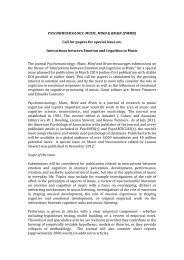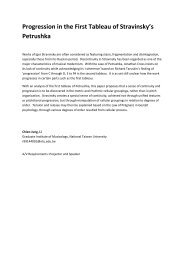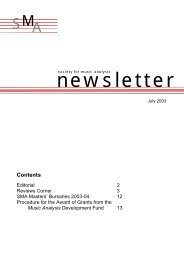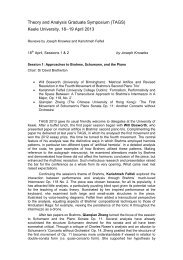Newsletter No. 31 (January 2009) (PDF) - Society for Music Analysis
Newsletter No. 31 (January 2009) (PDF) - Society for Music Analysis
Newsletter No. 31 (January 2009) (PDF) - Society for Music Analysis
You also want an ePaper? Increase the reach of your titles
YUMPU automatically turns print PDFs into web optimized ePapers that Google loves.
manipulation of musical parameters; so, <strong>for</strong>example, William Henderson saidsensuousness was composed of rhythm,melody and harmony, while Henry Jamesdescribed tone-colour as music's mostsensuous component. The one speaker whoseemed to rein<strong>for</strong>ce Hawkins' point was IanBiddle (Newcastle), who argued thatsensuousness was a cultural idea, and,there<strong>for</strong>e, that any attempt to analyse itautomatically relied on culturally-definedframes of reference.The need to find additional, new ways ofanalysing sensation in music was expressedby many speakers: Carlo Nardi (Università diTrento) looked at mimesis in electronic musicto help explain the proliferation of live visualsin electronic per<strong>for</strong>mances; and JustinWilliams (<strong>No</strong>ttingham) described how he useda more frequency-based, rather than the moretraditional pitch-based, analysis <strong>for</strong>understanding the nature of sub-bass in hiphopcar culture: frequency being particularlyimportant <strong>for</strong> explaining how dynamiccompression can add to fullness of sound, <strong>for</strong>example.Sub-bass turned out to be a mini-theme of theday, as the keynote speaker, Steve Goodman(East London), also talked about this topicextensively, though his interest was, moregenerally, in 'unsound': the thresholdsbetween hearing and touch, as in infrasound;between sound and silence, with ultrasound;and the untapped potential of the audiblefrequency range.Of course, all the outside stimuli weexperience have a sensuous nature. However,as Julian Henriques (Goldsmiths) argued,music's sensuous side is much more important<strong>for</strong> it than <strong>for</strong> language: indeed it is at the heartof its ability to move us. While languagestructures the world in terms of opposed,diacritical (or digital) ideas, music usescontinuous (or analogue) variation to allow usto think through sound. He also argued thatthis sensuous meaning could not be separatedfrom syntactic structure: that sensuousnessand analysis are not binaries, but, rather, havean intimate relationship. This idea seemedneatly to sum up the viewpoint of manyspeakers in this fascinating study day.Simon JonesSMA events <strong>2009</strong>24–25 April <strong>2009</strong>Bach‟s PassionsSMA Spring Study Day(Glasgow University)Contact: John ButtEmail: j.butt@music.gla.ac.uk1–2 May <strong>2009</strong>SMA TAGS Day <strong>for</strong> Postgraduates(Durham University)Contact: Jo BuckleyEmail: jo.buckley@durham.ac.uk13–15 July <strong>2009</strong>SMA, IMR and Wiley-Blackwell SummerSchool in <strong>Analysis</strong>(Durham University)Contact: Michael SpitzerEmail: michael.spitzer@durham.ac.uk<strong>31</strong> August–3 September <strong>2009</strong>SMA Conference on <strong>Music</strong> and Emotion(Durham University)Contact: Jo BuckleyEmail: jo.buckley@durham.ac.ukAutumn <strong>2009</strong> (date to be confirmed)Per<strong>for</strong>mance CriticismSMA Autumn Study Day(Middlesex University)Contact: Anthony GrittenEmail: A.Gritten@mdx.ac.ukSMA newsletter 14







